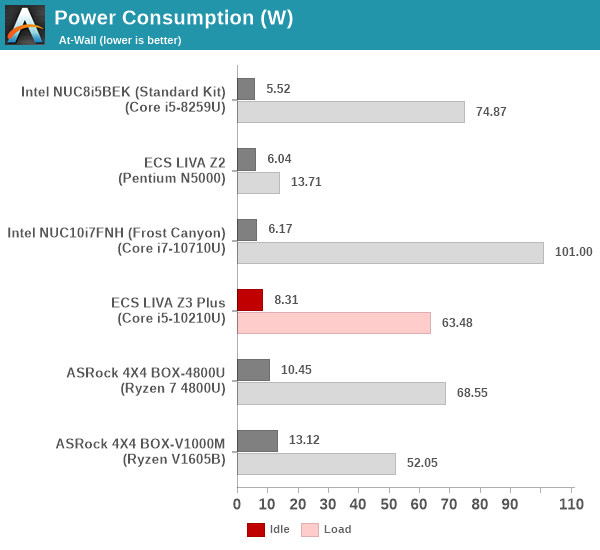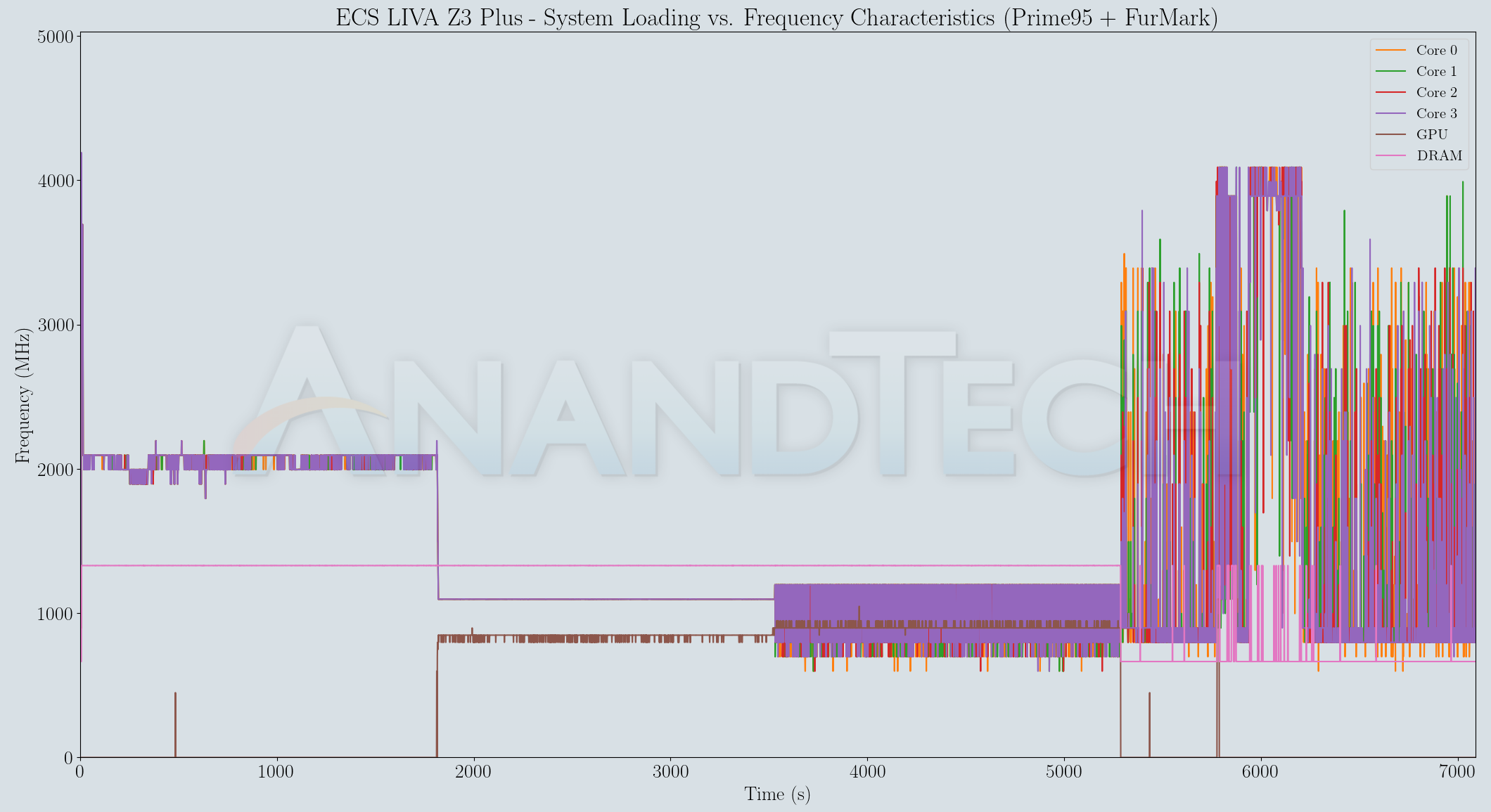ECS LIVA Z3 Plus Review: Compact Comet Lake NUC Clone Cuts Corners
by Ganesh T S on December 22, 2020 8:00 AM ESTMiscellaneous Aspects and Concluding Remarks
Small form-factor machines are an attractive proposition due to their ability to be installed in space-constrained locations. The design of such machines is made possible due to lower platform power consumption numbers compared to traditional desktops in the tower form-factor. It is also important to evaluate the thermal performance of the system under sustained load. Prior to providing our concluding thoughts on the ECS LIVA Z3 Plus, we take a look at these aspects.
Power Consumption
The power consumption at the wall was measured with a 4K display being driven through the HDMI port. In the graphs below, we compare the idle and load power of the ECS LIVA Z3 Plus with other low power PCs evaluated before. For load power consumption, we ran the AIDA64 System Stability Test with various stress components, and noted the maximum sustained power consumption at the wall.

Despite the use of a SATA SSD and only one memory channel, the idle power consumption is still a tad too high - It may be possible to tweak BIOS settings to minimize the idle power further. In any case, it is still better than that of the AMD-based systems. The load power consumption of around 63W is reached only for very short durations, as we shall see further down. The at-wall power is around 27W under sustained loading, as we shall see in the next sub-section.
Thermal Performance
Our thermal stress routine starts with the system at idle, followed by four stages of different system loading profiles using the AIDA64 System Stability Test (each of 30 minutes duration). In the first stage, we stress the CPU, caches and RAM. In the second stage, we add the GPU to the above list. In the third stage, we stress the GPU standalone. In the final stage, we stress all the system components (including the disks). Beyond this, we leave the unit idle in order to determine how quickly the various temperatures in the system can come back to normal idling range. The various clocks, temperatures and power consumption numbers for the system during the above routine are presented in the graphs below.
| ECS LIVA Z3 Plus System Loading with the AIDA64 System Stability Test | |||

A look at the power consumption graph shows that the system is designed to support the Core i5-10210U running with a TDP of 15W. Throughout the stress duration, the power number is sustained - and under those conditions, the temperature of the package never goes above 85C. But, this does come at the cost of fan noise.
| ECS LIVA Z3 Plus System Loading with Prime95 and Furmark | |||

The observations in the custom stress test involving Prime95 and Furmark are the same - the package dissipates around 15W with the number split between the GPU and CPU appropriately based on the load on either. The thermal solution for the system has no issues in handling it.
Final Words
Companies like ECS have been in the PC space for a long while, and can be trusted upon to provide reliable systems. One of the key things we have observed in the industry while evaluating products from such companies is that the offerings are never bad products, but the pricing can make it appear so. The ECS LIVA Z3 Plus falls under this category. In order to evaluate the value proposition, we consider the lowest price online for the LIVA Z3 Plus - $556. A consumer with limited technical knowledge can instead make three purchases - a $380 NUC10i5FNK, a $51 WD Blue NVMe SSD for 500GB, and a 16GB DDR4-2666 SODIMM kit for $60 working out to a total cost of $491. For $65 less, the Frost Canyon configuration provides a Thunderbolt 3 port, better balance with 10Gbps USB 3.2 Gen 2 ports (compared to 5 Gbps USB 3.2 Gen 1 in the Z3 Plus), and better memory hierarchy components (16GB dual-channel DRAM vs. 4GB single-channel, and a 500GB NVMe SSD vs. a 128GB SATA SSD). The LIVA Z3 Plus does cater to some niche use-cases needing two wired LAN ports and/or a mini-DP port for installation in a space-limited location - however, it is unclear whether such requirements would justify a $65 premium over a platform with arguably better all-round credentials.
The practice of vendors delivering systems with only one memory channel utilized simply needs to stop. The intent may be to keep the cost down, but the experience of the non-technical user (one likely to buy an off-the-shelf mini-PC with pre-installed RAM and SSD) suffers greatly. These are typically the folks who do not realize the reason for the less-than-ideal performance. The ECS LIVA Z3 Plus would have earned our unqualified recommendation were it to be sold barebones at a price south of $375 (given the direct competition from Intel's NUC10i5FNK at around $380). As it stands, we believe the unit is priced much higher than expected for its feature set.
On the positive side, the new chassis design - flatter and a bit wider compared to the standard NUC chassis - is subjectively more pleasing to the eye. The USB ports are also not stacked, and all of them are in the front panel - enabling easier access if the use-case demands frequent swapping of USB peripherals. Having only the connect-and-forget ports like the display outputs and NICs on the rear panel lends itself to good user-experience. Unlike some of the other Comet Lake SFF PCs in the market, the LIVA Z3 Plus comes with Wi-Fi 6 support. Similar to the Frost Canyon NUC, and unlike many other CML-U offerings, the LIVA Z3 Plus also comes with built-in digital microphones (the four pinholes in the front panel) - this enables the usage of the PC as an Alexa device and opens up a host of interesting applications. Consumers contemplating a Comet Lake-U mini-PC for use-cases that involve the need for native dual LAN capabilities or a mini-DP output in a compact footprint (without external adapters) should definitely look at the ECS LIVA Z3 Plus. Post-purchase, they would do well to ensure that both memory slots are occupied.











15 Comments
View All Comments
JfromImaginstuff - Tuesday, December 22, 2020 - link
Waiting for the guy who says,"where's the and variant" or something along those linesedzieba - Tuesday, December 22, 2020 - link
And the inevitable "AMD exists so nobody is allowed to review Intel products!!1!" brigade.nandnandnand - Tuesday, December 22, 2020 - link
No AMD, no buy.stephenbrooks - Tuesday, December 22, 2020 - link
The ASRock 4X4 is in the comparison table, so your AMD SFFPC is there.Hul8 - Wednesday, December 23, 2020 - link
Also, I think as long as AMD keeps bringing new architectures to mobile/APUs late, and Intel keeps leading their new tech with mobile chips, most manufacturers will prioritize Intel for these systems. Doesn't hurt that they can get sweet bundle deals for WiFi 6 and Ethernet, too.chrnochime - Thursday, December 24, 2020 - link
Well it'd be AMD and not "and" for starters LOLShowtime - Tuesday, December 22, 2020 - link
This looks better than the Nuc to me, but all 4 USB ports on the front, make a no go. There's always 2-3 things plugged in, and I prefer those things in the back of the case. It being a bad value proposition is unfortunate. This is like many tech items, that could have been great, but will end up on sale for 50% off next year. Will cite this article when that happens.Impetuous - Tuesday, December 22, 2020 - link
Agree with you on the ports. I have the original LIVA Z for TV / media use and would much prefer to route external HDDs and Skype cameras from the back to keep cords away from grasping toddlers. Only thing I want up front is the wireless keyboard USB. All ports on the back is more of a deal breaker than the price for me...Impetuous - Tuesday, December 22, 2020 - link
Sorry, all ports on front*The_Assimilator - Tuesday, December 22, 2020 - link
Allow me to introduce you to a simple and inexpensive device called a "USB hub".